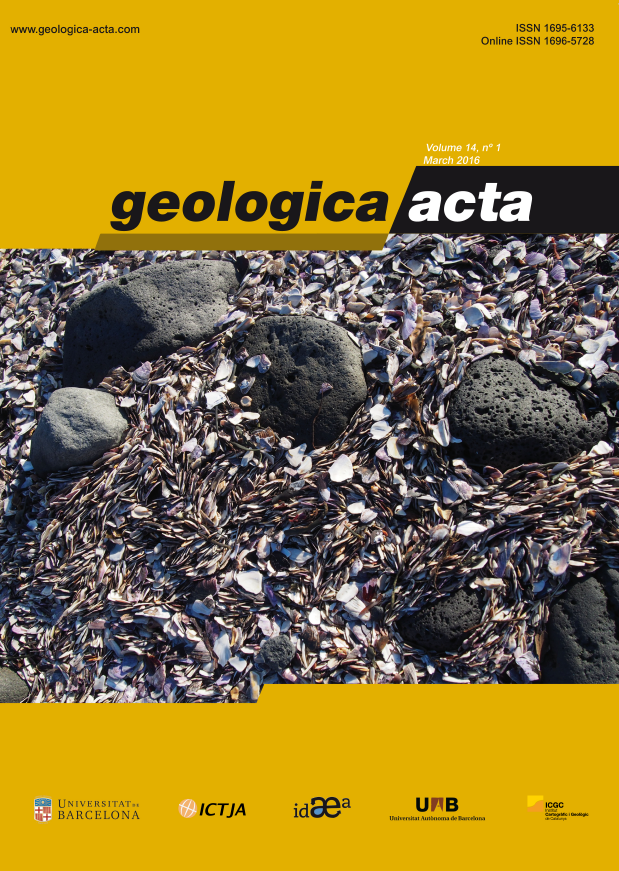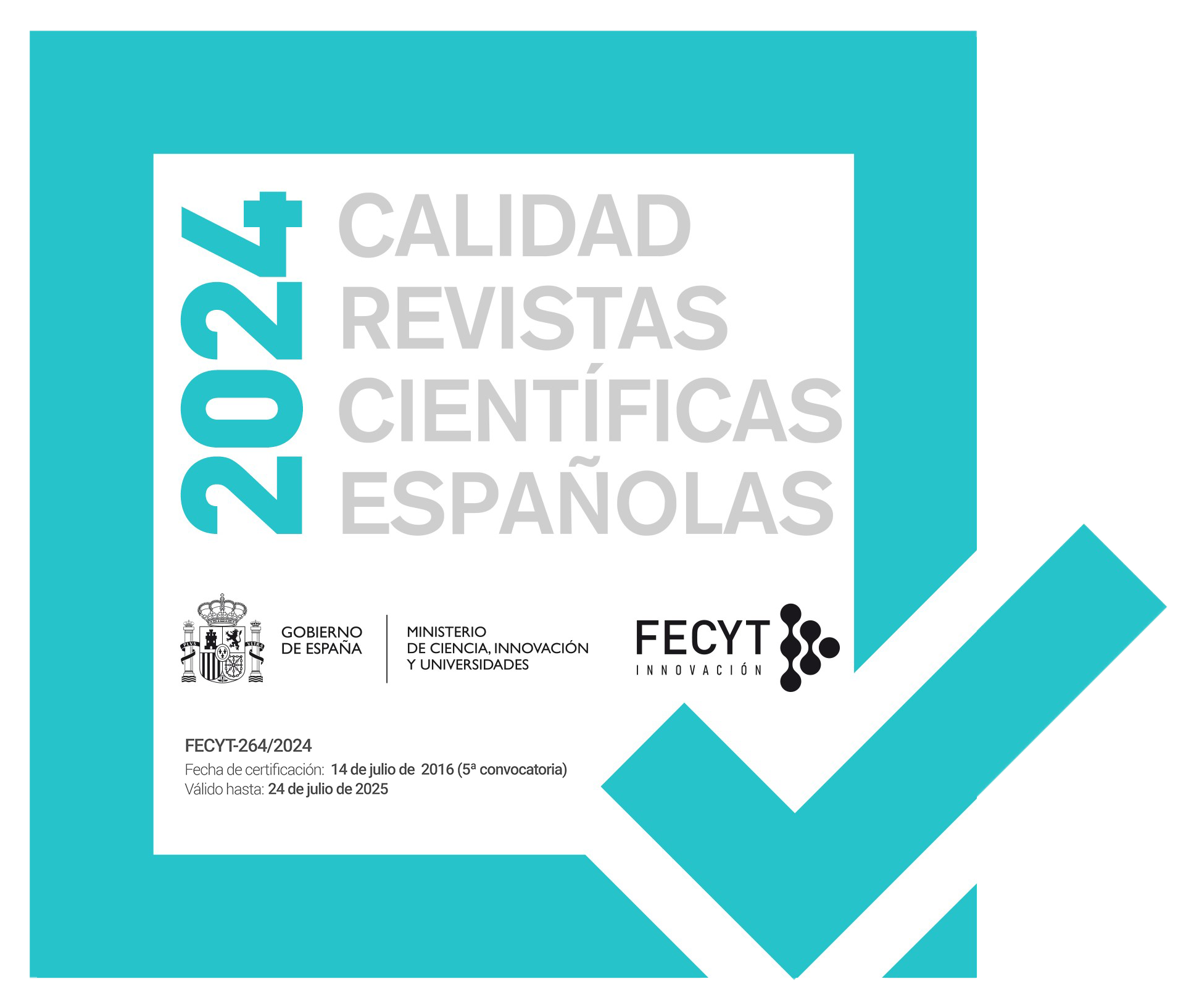Exceptional preservation of Miocene pollen: plasmolysis captured in salt?
DOI:
https://doi.org/10.1344/GeologicaActa2016.14.3Keywords:
Pollen, Salt, Plasmolysis, Exceptional preservation, MioceneAbstract
Exceptionally well-preserved Miocene pollen from the Bochnia salt mine of southern Poland is reported herein. The halite deposits within the salt mine belonging to Late Badenian (Miocene) marine evaporites originated in the Paratethys. Rounded and angular structures are present inside pollen grains. On the basis of the similarity with plasmolyzed pollen grains of modern plants, these structures are considered to represent cytoplasms plasmolyzed in the condensed brine prior to fossilization. Two forms of plasmolyzed cytoplasms (concave and convex) can be observed in modern pollen. Both are distinguished in the investigated fossil material. In porate and colporate grains the shape of the plasmolyzed cellular content is concave while in inaperturate it is convex. The plasmolysis form depends on the type of apertures and pollen shape. The percentage of pollen with fossilized cytoplasms within individual taxa is a valuable environmental indicator, as it depends on the proximity of the pollen-producing plant assemblages to the depositional setting.
References
Andreyeva-Grigorovich, A.S., Oszczypko, N., Savitskaya, N.A., Ślączka, A., Trofimovich, N.A., 2003. Correlation of Late Badenian salts of the Wieliczka, Bochnia and Kalush areas (Polish and Ukrainian Carpathian Foredeep). Annales Societatis Geologorum Poloniae, 73, 67-89.
Bąbel, M., 2004. Badenian evaporite basin of the northern Carpathian Foredeep as a drawdown salina basin. Acta Geologica Polonica, 54(3), 313-337.
Bennett, K.D., Parducci, L., 2006. DNA from pollen: principles and potential. The Holocene, 16(8), 1031-1034.
Bomfleur, B., McLoughlin, S., Vajda, V. 2014. Fossilized nuclei and chromosomes reveal 180 million years of stasis in royal
ferns. Science, 343, 1376-1377.
Bukowski, K., 1994. Sedimentary environment and origin of the boulder salt deposits of the Wieliczka deposit (Miocene, southern Poland) (in Polish, with English summary). Przegląd Geologiczny, 47, 754-758.
Bukowski, K., 1999. Comparison of the Badenian saliferous series from Wieliczka and Bochnia in the light of new data (in Polish, with English summary). Prace Państwowego Instytutu Geologicznego, 168, 43-56.
Campbell, I.D., Campbell, C., 1994. Pollen preservation: experimental wet-dry cycles in saline and desalinated sediments. Palynology, 18, 5-10.
Caputo, M., Bosio, L.A., Corach, D., 2011. Long-term room temperature preservation of corpse soft tissue: an approach for tissue sample storage. Investigative Genetics, 2, 17.
Dafni, A., Firmage, D., 2000. Pollen viability and longevity: practical, ecological and evolutionary implications. Plant Systematics and Evolution, 222, 113-132.
De Vries, H., 1877. Untersuchungen über die mechanischen Ursachen der Zellstreckung ausgehend von der Einwirkung von Salzlosungen auf den Turgor wachsender Pflanzenzellen. Leipzig, W. Engelmann, 120pp.
De Franceschi, D., Dejax, J., De Ploëg, G., 2000. Extraction du pollen inclus dans l’ambre [Sparnacien du Quesnoy (Oise), basin de Paris]: vers une nouvelle spécialité de paléopalynologie. Comptes Rendus de l’Académie des Sciences, Sciences de la Terre et des Planètes, Earth and Planetary Sciences, 330, 227-233.
Dejax, J., De Franceschi, D., Lugardon, B., De Ploëg, G., Arnold, V., 2001. Le contenu cellulaire du pollen fossilisé dans l’ambre, preservé à l’état organique. Comptes Rendus de l’Académie des Sciences, Sciences de la Terre et des Planètes,
Earth and Planetary Sciences, 332, 339-344.
Edwards, D., Axe, L., 2004. Anatomical evidence in the detection of the earliest wildfires. Palaios, 19(2), 113-128.
Elsik, W.C., 1966. Biologic degradation of fossil pollen grains and spores. Micropaleontology, 12, 515-518.
Elsik, W.C., 1971. Microbiological degradation of sporopollenin. In: Brooks, J., Grant, P.R., Muir, M., van Gijzel, P., Shaw, G. (eds.). Sporopollenin. New York, Academic Press, 480-511.
Garlicki, A., Wiewiórka, J., 1981. The distribution of bromine in some halite rock salts of the Wieliczka salt deposit (Poland). Annales Societatis Geologorum Poloniae, 51(3/4), 353-359.
Garlicki, A., Szybist, A., Kasprzyk, A., 1991. Trace elements studies from salt and chemical deposits (in Polish, with English summary). Przegląd Geologiczny, 39(11-12), 520-527.
Gaździcka, E., 1994. Nannoplankton stratigraphy of the Miocene deposits in Tarnobrzeg area (northeastern part of the Carpathian Foredeep). Geological Quarterly, 38, 553-570.
Glauser, A.L., Harper, C.J., Taylor, T.N., Taylor, E.L., Marshall, C.P., Olcott Marshall, A., 2014. Reexamination of cell content in Pennsylvanian spores and pollen grains using Raman spectroscopy. Review of Palaeobotany and Palynology, 210, 62-68.
Goldstein, S., 1960. Destruction of pollen by Phycomycetes. Ecology, 41, 543-545.
Hall, J.W., 1971. A spore with cytoplasm-like contents from the Cretaceous of Minnesota, USA. Pollen et Spores, 13, 163-168.
Kizilsthein, Y.Ya., Shpitsglus, A.L., Nastavkin, A.V., 2003. Microstructures of the plant cell of the Carboniferous age. In: Wong, T.E. (ed.). Proceedings of the XV International Congress on Carboniferous-Permian Stratigraphy, Utrecht (The Netherlands), 276-277.
Kovar-Eder, J., Jechorek, H., Kvaek, Z., Parashiv, V. 2008. The integrated plant record: an essential tool for reconstructing Neogene zonal vegetation in Europe. Palaios, 23, 97-111.
Lee-Stadelmann, O.Y., Bushnell, W.R., Stadelmann, E.J., 1984. Changes in plasmolysis form in epidermal cells of Hordeum
vulgare infected by Erisyphe graminis: evidence for increased membrane-wall adhesion. Canadian Journal of Botany, 62,
-1724.
Lopes Loguercio, L., 2002. Pollen treatment in high osmotic potential: a simple tool for in vitro preservation and manipulation of viability in gametophytic populations. Brazilian Journal of Plant Physiology, 14(1), 65-70.
Łańcucka-Środoniowa, M., Zastawniak, E., 1997. The MiddleMiocene flora of Wieliczka revision of Jan Zabłocki’s collection. Acta Palaeobotanica Polonica, 37(1), 17-49.
Mai, D.H., 1995. Tertiäre Vegetationsgeschichte Europas. New York, Jena, Gustav Fischer Verlag, 691pp.
Masure, E., Dejax, J., De Ploëg, G., 2013. Blowin’ in the wind… 100 Ma old multi-staged dinoflagellate with sexual fusion trapped in amber: Marine-freshwater transition. Palaeogeography, Palaeoclimatology, Palaeoecology, 388, 128-144.
Niklas, K.J., Brown, R.M., Santos, R., Vian, B., 1978. Ultrastructure and cytochemistry of Miocene angiosperm leaf tissue. Proceedings of the National Academy of Science of the United States of America, 75, 3263-3267.
Oparka, K.J., 1994. Plasmolysis: new insights into an old process. New Phytologist, 126, 571-591.
Peryt, T.M., 1999. Calcareous nannoplankton assemblages of the Badenian evaporites in the Carpathian Foredeep. Biuletyn
Państwowego Instytutu Geologicznego, 387, 158-161.
Reddy, P.R., Goss, J.A., 1971. Effect of Salinity on Pollen. I. Pollen Viability as Altered by Increasing Osmotic Pressure with NaCl, MgCl2, and CaCl2. American Journal of Botany, 58(8), 721-725.
Sachs, T., 1972. The pattern of plasmolysis as a criterion for intercellular relations. Israel Journal of Botany, 21, 90-98.
Taylor, T.N., Millay, M.A., 1977. Structurally preserved fossil cell contents. Transactions of the American Microscopical Society, 96, 390-393.
Van Couvering, J.A., Aubry, M.P., Berggren, W.A., Bujak, J.P., Naeser, C.W., Wieser, T., 1981. The terminal Eocene event and the Polish connection. Palaeogeography, Palaeoclimatology, Palaeoecology, 36, 321-362.
Van der Ham, R.W.J.M., van Konijnenburg-van Cittert, J.H.A., Dortangs, R.W., Herngreen, G.F.W., van der Burgh, J., 2003. Brachyphyllum patens (Miquel) comb. nov. (Cheirolepidiaceae?): remarkable conifer foliage from the Maastrichtian type area (Late Cretaceous, NE Belgium, SE Netherlands). Review of Palaeobotany and Palynology, 127, 77-98.
Wang, X., 2004. Plant cytoplasm preserved by lightning. Tissue and Cell, 36, 351-360.
Wang, X., Dilcher, D.L., 2005. The preservation of cytoplasm in fossil plant cells. Geochimica et Cosmochimica Acta, 69 (10, Supplement), A342.
Wang, X., Du, K., Yi, T., Jin, J. 2010. Cytoplasmic remains in an Eocene fossil stem. IAWA Journal, 31(3), 363-367.
Wang, X., Liu, W., Du, K., He, X., Jin, J., 2014. Ultrastructure of chloroplasts in fossil Nelumbo from the Eocene of Hainan Island, South China. Plant Systematics and Evolution, 300, 2259-2264.
Warren, J.K., 2006. Evaporites: Sediments, Resources and Hydrocarbons. Berlin, Heidelberg. Springer-Verlag, 943pp.
Ważyńska, H., Piwocki, M., Ziembińska-Tworzydło, M., Grabowska, I., Kohlman-Adamska, A., Słodkowska, B., Stuchlik, L., 1998. Palynology and Palaeogeography of the Neogene in the Polish Lowlands. Prace Państwowego Instytutu Geologicznego, Warszawa, Polish Geological Institute, 160, 45pp.
Wieser, T., Bukowski, K., Wójtowicz, A., 2000. Mineral correlation and radiometric age of tuffite from Chodenice Beds from vicinity of Bochnia (In Polish, with English abstract). In: Kusiak, M., Paszkowski, M. (eds.). 5 Ogólnopolska Sesja Naukowa: Datowanie Minerałów i Skał (5th National Science Session on: Dating rock and minerals). Institute of Geological Sciences, Kraków, Polish Academy of Sciences, 50-55.
Willerslev, E., Hansen, A.J., Binladen, J., Brand, T.B., Gilbert, M.T.P., Shapiro, B., Bunce, M., Wiuf, C., Gilichinsky, D.A., Cooper, A., 2003. Diverse plant and animal genetic records from Holocene and Pleistocene sediments. Science, 300, 791-795.
Zabłocki, J,. 1928. Tertiäre flora des Salzlagers von Wieliczka. Acta Societatis Botanicorum Poloniae, 5(2), 174-208.
Zabłocki, J,. 1930. Tertiäre flora des Salzlagers von Wieliczka II. Acta Societatis Botanicorum Poloniae, 7(2), 139-156.
Downloads
Published
Issue
Section
License

This work is licensed under a Creative Commons Attribution-ShareAlike 4.0 International License.
Copyright
Geologica Acta is the property of the UB, GEO3BCN, IDAEA and UAB. Geologica Acta must be cited for any partial or full reproduction. Papers are distributed under the Attribution-Share Alike Creative Commons License. This license allows anyone to reproduce and disseminate the content of the journal and even make derivative works crediting authorship and provenance and distributing possible derivative works under the same or an equivalent license.
Author Rights
Authors retain the copyright on their papers and are authorized to post them on their own web pages or institutional repositories. The copyright was retained by the journal from the year 2003 until 2009. In all cases, the complete citation and a link to the Digital Object Identifier (DOI) of the article must be included.
The authors can use excerpts or reproduce illustrations of their papers in other works without prior permission from Geologica Acta provided the source of the paper including the complete citation is fully acknowledged.




